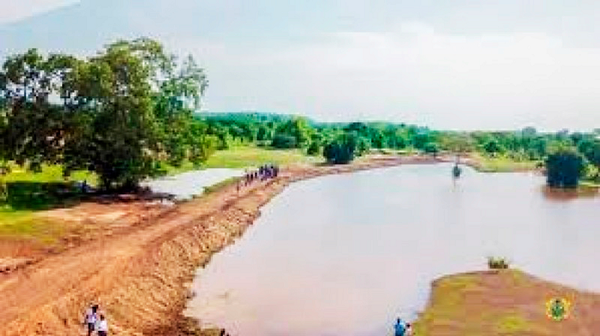The Pwalugu Multipurpose Dam Project is a significant infrastructure initiative aimed at providing irrigation, flood control, and hydroelectric power to the Upper East Region of Ghana. Despite its potential benefits, the project has faced numerous challenges, including financial malfeasance and delays. This article explores the historical evolution of the project, its benefits, the issues encountered during the Akufo-Addo-Bawumia administration, and recommendations for the current administration to ensure its successful completion.
HISTORICAL EVOLUTION
The idea of constructing the Pwalugu Multipurpose Dam dates back to the early 1960s. However, it wasn’t until the 1990s that prefeasibility studies were conducted. In 2013, the Volta River Authority (VRA), with financial support from the Agence Française de Développement (AFD) and technical assistance from the World Bank, initiated a feasibility study and Environmental and Social Impact Assessment (ESIA) for the project.
In 2019, the Government of Ghana, under the Akufo-Addo-Bawumia administration, decided to implement the project. The sod-cutting ceremony was held in November 2019, marking the official commencement of the project. The project was awarded to PowerChina, with a construction period of 50 months.
BENEFITS OF THE PWALUGU MULTIPURPOSE DAM
The Pwalugu Multipurpose Dam is expected to provide several benefits, including:
1. Irrigation:
– The dam will irrigate approximately 25,000 hectares of farmland, enhancing agricultural productivity and food security in the region.
2. Flood Control:
– The dam will help mitigate the frequent flooding in the White Volta Basin, protecting lives and properties downstream.
3. Hydropower Generation:
– The project includes a hydroelectric power plant with a capacity of 60 megawatts, contributing to Ghana’s renewable energy goals.
4. Economic Development:
– The dam will boost economic activities in the Upper East and North East regions, attracting large-scale commercial farms and supporting local farmers.
CHALLENGES AND FINANCIAL MALFEASANCE
Despite its potential benefits, the Pwalugu Multipurpose Dam project has faced significant challenges:
1. Financial Malfeasance:
– The project has been marred by allegations of financial mismanagement. Over $11.9 million was paid to the contractor, PowerChina, without significant progress on the project. This has raised concerns about the misuse of public funds and the need for accountability. Key figures involved in the financial malfeasance include Vice President Dr. Mahamudu Bawumia and other officials within the administration.
2. Delays:
– The project has experienced numerous delays due to financial constraints and bureaucratic hurdles. The contractor reportedly abandoned the project sites, causing frustration among local communities.
3. Lack of Progress:
– Despite the initial enthusiasm, little to no work has been done on the project sites. This has led to public outcry and demands for an investigation into the disbursement of funds.
RECOMMENDATIONS FOR THE MAHAMA ADMINISTRATION
To ensure the successful completion of the Pwalugu Multipurpose Dam project, the following steps are recommended for the Mahama administration:
1. Conduct a Thorough Audit:
– Initiate an immediate audit of the project to identify any financial irregularities and hold those responsible accountable. This will help restore public trust and ensure transparency.
2. Secure Dedicated Funding:
– Allocate dedicated funding for the project to avoid financial constraints and ensure continuous progress. Explore alternative funding sources, such as public-private partnerships and international grants.
3. Enhance Oversight and Accountability:
– Establish a robust oversight mechanism to monitor the project’s progress and ensure efficient use of resources. This could involve regular reporting and independent audits.
4. Engage Stakeholders:
– Involve local communities, farmers, and other stakeholders in the project’s planning and implementation. This will ensure that the project meets the needs of the beneficiaries and fosters community support.
5. Utilize Media Platforms:
– Utilize the state, private and social media platforms to provide regular updates on the project’s progress and educate the public on its benefits. This will enhance transparency and keep the public informed.
CONCLUSION
The Pwalugu Multipurpose Dam project holds immense potential for the economic and social development of the Upper East Region and Ghana as a whole. However, addressing the challenges of financial malfeasance and delays is crucial to realizing these benefits. By implementing the recommended steps, the Mahama administration can ensure the successful completion of the project, providing much-needed irrigation, flood control, and hydropower to the region.
As Chinua Achebe wisely said, “One of the truest tests of integrity is its blunt refusal to be compromised.” This reflects the need for transparency and accountability in the project’s execution. Fusaini Isah’s Dogomba Wise Proverb emphasizes, “It takes more than one finger to eat a meal,” highlighting the importance of collaboration and community involvement.
From a biblical perspective, Proverbs 11:14 states, “Where there is no guidance, a people falls, but in an abundance of counselors there is safety.” This underscores the importance of diverse perspectives and expertise in ensuring the project’s success. An international perspective from Nelson Mandela reminds us, “The ballot is stronger than the bullet,” emphasizing the power and importance of credible and effective governance in achieving development goals.
By addressing the challenges and implementing the recommendations, the Pwalugu Multipurpose Dam project can become a cornerstone of sustainable development, benefiting farmers in the region and Ghanaians at large.
Retired Senior Citizen
Teshie-Nungua


